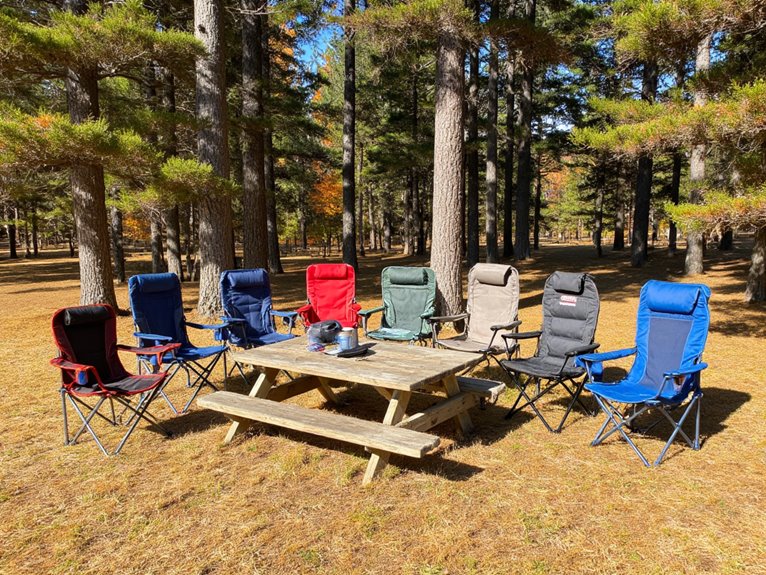What Is Something a Hiker Should Always Have Before Going on His First Hike?
Before venturing out on their first hike, a hiker should always prioritize preparation and safety. This includes informing someone of their itinerary, checking the weather forecast, and packing essential gear such as a first-aid kit, navigation tools, and reliable communication devices. It's also crucial to wear breathable, moisture-wicking clothing and sturdy, waterproof hiking boots. Additionally, bringing a whistle, space blanket, and extra food and water can ensure a safe and enjoyable experience. By taking these necessary precautions, hikers can minimize risks and maximize their time on the trail, and by taking the next step, they can unlock a world of outdoor adventure.
We are supported by our audience. When you purchase through links on our site, we may earn an affiliate commission, at no extra cost for you. Learn more. Last update on 28th December 2025 / Images from Amazon Product Advertising API.
Proper Hiking Attire and Footwear
When venturing out on your first hike, proper hiking attire and footwear are vital to guarantee a safe and enjoyable experience.
Ill-fitting or inadequate clothing can lead to discomfort, distraction, and even injury.
Opt for breathable, moisture-wicking fabrics that allow for a full range of motion. Look for pants and shirts with built-in UPF protection to shield against the sun.
Footwear is equally essential, as it provides support, stability, and traction. Choose sturdy, waterproof hiking boots or trail running shoes with aggressive tread patterns to handle various terrain.
Don't forget to break in your shoes before setting out on your hike to prevent blisters and discomfort.
When venturing into the wilderness, navigation tools and maps are essential for ensuring a safe and enjoyable hike.
To navigate effectively, mastering map symbols, reading trail signs accurately, and using a compass correctly are vital skills.
Understanding Map Symbols
Understanding map symbols is vital for traversing the wilderness safely and efficiently.
Familiarize yourself with the legend, which explains the meaning of symbols, colors, and markings.
Pay attention to contour lines, which indicate elevation and steepness.
Note the difference between trails, roads, and boundaries.
Be aware of symbols indicating water sources, campsites, and points of interest.
Reading Trail Signs
In conjunction with map-reading skills, the ability to decipher trail signs is a vital navigation tool that helps hikers stay on course and avoid potential dangers.
Trail signs provide valuable information, such as trail names, directions, and distances. They can also indicate potential hazards, like steep drop-offs or wildlife habitats.
When reading trail signs, hikers should pay attention to symbols, colors, and arrows, which can indicate the direction of the trail or warn of potential dangers.
It's essential to take note of any signs indicating private property or restricted areas to avoid trespassing.
Using a Compass
A reliable compass is an indispensable navigation tool that provides hikers with a precise and consistent method of determining direction, even in the absence of visible landmarks or trail signs.
A compass helps hikers stay on course, especially in dense forests or during inclement weather.
Before using a compass, it's essential to set the declination, which is the difference between magnetic and true north.
Hold the compass level and still, then rotate the bezel to align the direction-of-travel arrow with the magnetic needle.
This guarantees accurate readings, allowing hikers to navigate confidently.
Always carry a compass as a backup to GPS devices, which can be unreliable in remote areas.
First Aid Kit Essentials
Accidents can and do happen on the trail, making a well-stocked first aid kit a crucial component of any hiker's backpack.
A basic first aid kit should include items such as bandages, antiseptic wipes, gauze pads, and pain relievers.
Additionally, it's essential to pack supplies to treat blisters, such as moleskin and blister pads.
Antihistamines for allergic reactions and any personal medications should also be included.
A first aid manual or guidebook can provide valuable information on how to administer basic first aid.
Remember to check the expiration dates of any medications and supplies, and restock as needed.
A well-prepared first aid kit can help hikers respond to minor injuries and prevent more serious complications.
Hydration and Energy Needs
When venturing out on your first hike, it's vital to prioritize hydration and energy needs to guarantee a safe and enjoyable experience.
Proper hydration is essential to prevent dehydration, heat exhaustion, and other heat-related illnesses, while adequate energy from snacks helps maintain physical performance and mental acuity.
In the following sections, we will delve into the essential items to include in your hydration and energy plans, including water bottle essentials, electrolyte balance tips, and snack selection guidelines.
Water Bottle Essentials
Proper hydration is crucial on a hike, as even mild dehydration can impair physical performance and increase the risk of heat-related illnesses, making it essential to pack a water bottle that meets your hydration and energy needs.
When choosing a water bottle, consider the capacity, material, and features.
A minimum capacity of 2 liters is recommended, and a BPA-free, durable, and lightweight material is ideal.
Look for bottles with measurement markings, leak-proof lids, and insulation to keep drinks hot or cold.
Additionally, consider a bottle with a built-in filter or purification tablets for safe drinking water in the wilderness.
A water bottle that meets these criteria will guarantee you stay hydrated and energized throughout your hike.
Electrolyte Balance Tips
In addition to staying hydrated, maintaining electrolyte balance is essential to prevent fatigue, muscle cramps, and dizziness on the trail.
Electrolytes, such as sodium, potassium, and calcium, regulate various bodily functions, including nerve and muscle function.
When electrolyte levels become imbalanced, performance suffers.
To maintain electrolyte balance, hikers should consume electrolyte-rich beverages or snacks, like sports drinks, coconut water, or electrolyte tablets, during and after hiking.
Aim to consume 300-600 mg of sodium per liter of fluid.
Additionally, incorporate electrolyte-dense foods like bananas (potassium), nuts (magnesium), and avocados (potassium) into your hiking diet.
Snack Selection Guidelines
When choosing snacks for hiking, consider their nutritional content, caloric density, and ease of digestion.
Opt for snacks rich in complex carbohydrates, such as nuts, dried fruits, and energy bars, which provide sustained energy release.
Electrolyte-rich snacks like bananas, avocados, and sports drinks help replenish lost salts.
Aim for snacks with a balance of protein, healthy fats, and complex carbohydrates to maintain energy levels and support muscle function.
Avoid heavy, greasy, or high-fiber snacks that may cause digestive discomfort.
Select snacks that are lightweight, easy to consume on-the-go, and can withstand varying temperatures.
Emergency Shelter and Warmth
In the event of an unexpected overnight stay, a lightweight emergency shelter and warmth provision can be a lifesaver.
A compact and waterproof shelter, such as a space blanket or a lightweight tent, can protect against harsh weather conditions.
Additionally, a warmth provision, like a warm hat and gloves, can help maintain body heat.
A sleeping bag or an emergency bivvy sack can also provide insulation.
To guarantee a safe and comfortable hiking experience, choose lightweight and compact options that are easy to carry.
When selecting an emergency shelter and warmth provision, consider the climate and terrain of your hiking location and pack accordingly.
Always check the weather forecast and adjust your gear accordingly to facilitate a safe and comfortable hiking experience.
Reliable Communication Devices
A reliable means of communication is vital in case of an emergency, and a personal locator transmitter (PLT) or satellite phone can be a lifesaver when venturing into areas with no cellular service.
These devices enable hikers to send distress signals or make calls for help in emergency situations.
It's essential to choose a device that suits your hiking plans, considering factors like coverage, battery life, and durability.
Additionally, make sure to test your device before heading out and inform someone of your itinerary and expected return time.



